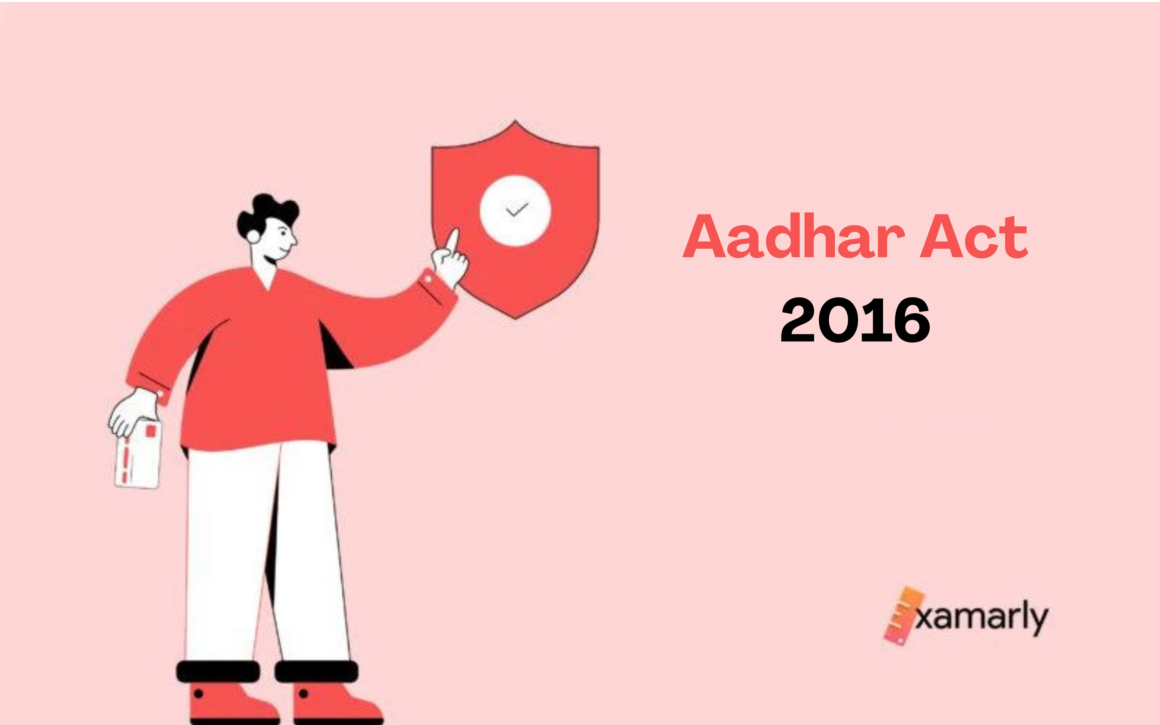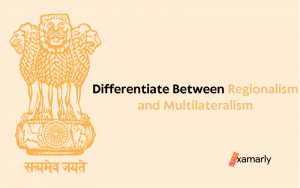By giving residents of India unique identity numbers and paying attention to important aspects, the Aadhaar Act 2016 promotes efficient, transparent good governance and targeted delivery of benefits, subsidies, and services.
This article “Aadhaar Act 2016” is significant in UPSC Civil Services Exam because the Governance section of UPSC CSE Mains GS paper-2 includes this topic.
Aadhar Act 2016
The Aadhaar Act 2016, which is officially known as Aadhaar (Targeted Delivery of Financial and Other Subsidies, Benefits and Services) Act, 2016 was introduced by Minister of Finance, Mr Arun Jaitley to provide financial and other benefits to Indian citizens. It is mandatory for every Indian resident to register for an Aadhar Card.
The Aadhaar Act 2016 aims to deliver subsidies and services to Indian residents in a targeted manner by providing them with unique identifying numbers, called Aadhaar numbers. It makes it easier for the underprivileged and weaker segments of society to access financial services, making it an instrument for distributive justice and equality. Additionally, it may be used to track development-related measures in crucial sectors like healthcare and education, etc.
Salient Features
The Aadhaar Act 2016 is designed to provide welfare delivery to individuals. Every Individual has a unique aadhaar number. It can be used to verify identity for open bank accounts, and eliminate fake identities under various government schemes. It also facilitates efficiency in welfare programs like government subsidies.
Aadhaar can also be used to secure your retirement benefits. One can receive their pension online using their Aadhaar card. There should be no worries about fraudulent beneficiaries or filing false pension claims.
Aadhaar cards have another advantage: they make it easier to identify beneficiaries of different social schemes. Besides, Aadhaar is linked with voter identification, making it impossible for people to use multiple voter IDs to vote in the same election.
Another significant development made by aadhar is the payment system in bank services. The Aadhaar-enabled Payment System has made transaction instant by mobile phones and prevented from providing bank account details.
Eligibility
Every Indian ‘resident’, who’s living for a period or periods amounting to 182 days or more in the twelve months before applying for an aadhaar, is eligible for an aadhar card. This means NRIs or foreign nationals who meet these requirements are also eligible for an Aadhaar Card. The individual will be required to provide core Biometric details, such as a photo, fingerprint, and iris scan, in order to complete the application at the time of enrolment.
Aadhaar-based information does not provide proof of citizenship or residence. Yet, the Aadhaar ID number serves as proof of identity.
Aadhaar Act 2016 Security
The protection of credible identity information and authentication records of people, which is stored in the Central Identities Data Repository, shall be ensured by the Unique Identification Authority of India (UIDAI).
The authority will take all necessary steps to ensure that the data under its custody or control is safeguarded against unauthorized access, use, or disclosure that is prohibited by this Act or its implementing regulations, as well as against accidental or intentional destruction, loss, or damage.
Also Read: Aadhar Card And Right To Privacy
Cases When Information May Be Revealed
There are two cases in which information about an Individual may be revealed-
- In the Interest of National Security: A Joint Secretary in the central government may direct the disclosure of I an Aadhaar number, (ii) biometric data (including an iris scan, a fingerprint, and other biological characteristics specified by regulations), (iii) demographic data, and (iv) a photograph in the national security interest. An Oversight Committee made up of the Cabinet Secretary, the Secretaries of Legal Affairs, and Electronics and Information Technology will examine such a decision, which will be valid for six months.
- On Court’s order: authentication records can be disclosed on the court’s order.
Aadhaar Preliminary Clause
Clause 2(g) defined “Biometric information” as a photograph, a fingerprint, or an iris scan. “Demographic information” such as name, date of birth, and address are mentioned in Clause 2(k). Definition of “resident” eligible is mentioned under Clause 2(v).
Enrolment Clause Of Aadhaar
The Enrolment Clause will enable the central government to authenticate a person’s identity. The central government may need other categories of individuals to enroll by releasing a notification in the future.
Clause 6 states that the Unique Identification Authority of India (UIDAI) may need holders to submit additional biometrics and demographic data. It uses only the biometric information for authentication purposes. This information will never be shared with any third parties and will be stored in a database according to the clause.
Aadhaar Authentication Clause
Aadhaar Act 2016 Authentications Clause specifies that an entity can use an Aadhaar number to verify an individual’s identity at the time of authentication. This process can either be done through Aadhaar online services (electronic form) or offline in the Aadhaar enrolment center.
Clause 7 states that the recipient of a subsidy may be required to have an Aadhaar number. Clause 8 enables UIDAI to verify Aadhaar for other private and public institutions. According to Clause 8(4), UIDAI is permitted to share identification information but not biometric authentications. Clause 9 acknowledges that Aadhaar is not proof of citizenship or domicile.
Penalties For Offences
A requesting organization, enrolling agency, or a private entity that violates the rules could face a criminal penalty of imprisonment of up to 3 year and a fine of up to Rs.10,000 or Rs.1 lakh or even both.
For unapproved access or unauthorized access to the central database, including disclosing any data therein, a court may impose up to three years in prison and a least penalty of up to Rs.10 lakh for the offense.
Cognizance Of Offence
Without a complaint from the UID authority or its authorized representative, no court will take cognizance of offense in adhaar-related matters.
Unique Identification Authority Of India Aadhaar
The UIDAI (Unique Identification Authority of India) is established by the government and assigns this unique identifier. The purpose of the UIDAI is to verify an individual’s identity information and issue a 12-digit unique identification (UID) number.
UIDAI is composed of a chairman, two part-time members, and the CEO, who will be chosen by the Central Government to serve as Member Secretary of the Authority. UIDAI is responsible for collecting demographic and biometric information from residents, storing it in a central database, and allocating a 12-digit random number to the citizens of India, known as an Aadhaar Number.
The UIDAI’s Central Identities Data Repository will check the centralized database and the data entered. The government is working hard for the program’s success. UIDAI has a great mission ahead. UIDAI’s Central Identities Data Repository was set up to protect citizens from fraud and other malpractices. It has become the frontrunner in providing an identity method to the people of India.
Conclusion
The Aadhaar Act of 2016 encourages improved management and the efficient, transparent, and targeted provision of financial assistance and provision of benefits, subsidies, and services to Indian citizens. It enables the Unique Identification Authority of India (UIDAI) to issue a 12-digit random number to the citizens of India. It is done once after completing the required verification steps, which include registering fingerprints or biometric data.
According to some experts, this act has violated the fundamentals of privacy. But Government has issued some significant provisions for safeguarding citizens’ data and information. Like, Before using the information, the agency responsible for enrollment must get consent from the individual and If the individual refuses to grant consent, the UIDAI will take special measures to ensure that the number is only used for legal purposes.
The Aadhaar provides various entities with all the relevant information about an individual. Based on an individual’s Aadhaar authentication, the Aadhaar program will map a person’s land and property purchases, rail travel, banking services, subsidy benefits, and instant services. Moreover, It will be laid the roadmap for efficient and good governance.
FAQs
Q.1. What Is Aadhaar Act, 2016, And When It Was Passed?
The aadhaar Act 2016 aims to provide verifiable identity numbers and financial inclusion of residents of India to government policies. It was approved by the Lok Sabha in 11 March 2016 and became effective on July 12 of that same year.
Q.2. What Is The Use Of An Aadhaar Number?
The Aadhaar Act 2016 is designed to provide government benefits and effective service delivery of essential services to individuals. From mapping a person’s land and property purchases, rail travel, and Banks, Telecom Service Provider or Income Tax Department, this will provide an efficient, transparent, and targeted delivery of subsidies, benefits, and services.
Q.3. What Are The Issues Faced By The Aadhaar Act, 2016?
The Aadhaar Act raises privacy concerns and security of authentication records. some raises their concerns on regulations to link residents’ Aadhaar data with other databases and security of identity information. Such steps are not justified on the basis of national security or administrative efficiency.






